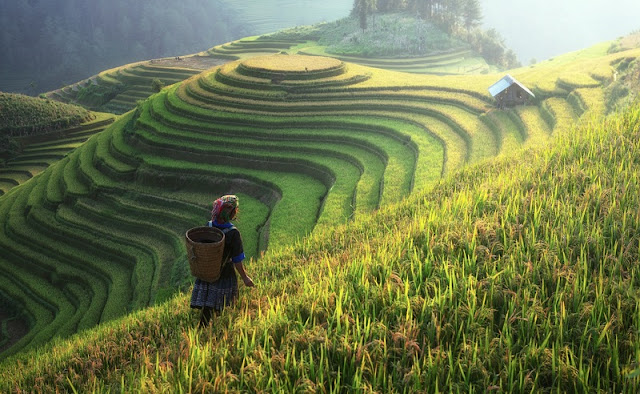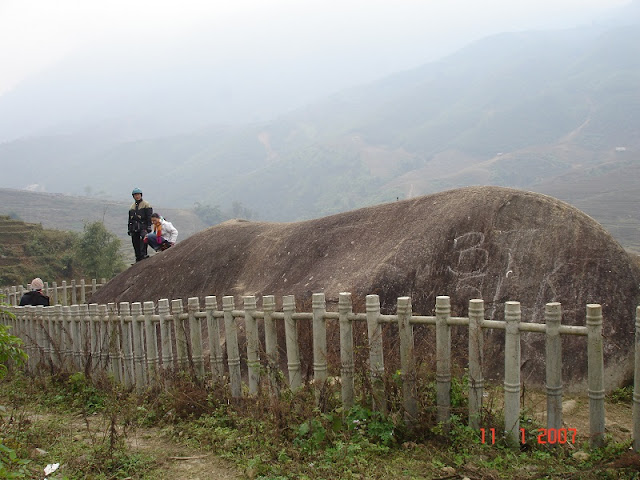Established as a hill station by the French in 1922, the town of Sapa is quaint with boutiques, spas and trendy eateries. But it’s the Muong Hoa Valley between the town and the Tonkinese Alps that’s really why travelers come to the far northwest of Vietnam.
- Experience a holiday with a difference at Topas Ecolodge
- Synthesize The Special Festivals in Sapa in The Spring 2018
The tourists come to Sapa Vietnam not only for the mountains shrouded in mist but also for valleys coated with the flowery blouses. One of the most beautiful in Sapa is Muong Hoa Valley where the prettiness and mystery converge.
Muong Hoa is one of the most famous destinations for breathtaking scenery and is the largest farmland for rice growing in SaPa. It is far from town about 14 kilometers. Going to visit Muong Hoa, you can trek along Muong Hoa River sneaking through the valley nearby SaPa town. It is a place, along through the mountains is a strange carved stones. Spread over 4 kilometers length, 2 kilometers width with at least 159 stones, Sapa’s Muong Hoa Valley has mysterious graphics.
The largest farmland of Sapa district
 |
| Photo by pxhere |
On the main road leading to Muong Hoa Valley, you will have opportunities to enjoy beauty of Muong Hoa valley. This valley has terraced fields which is the most beautiful terraced fields of Sapa. Cross the suspension bridge, you will be visiting the village of weaving and dyeing cloth of the Hmong and exploring Muong Hoa valley. Exploring the magnificent Muong Hoa Valley to enjoy its breathtaking landscapes, you will also paying visit to small and isolated hamlets and villages meet the Black H’mong, Zay and Red Zao at home.
Along Muong Hoa River
From the highest elevation of the mountain range covered by endless forest, rain water follows dozens of streams downhill to the floor forming the Muong Hoa, which follows across the small town and rice fields of the ethnic minority people of H’Mong, Dao and many others. They has been working on the slopping land and living their own ways for hundreds years.
 |
| Photo by pxhere |
Muong Hoa River peacefully flows through the valley, weaving itself along foots of mountains, nourishing the earth and the people. On rice season, the rice farmland valley serves up different shades of green and yellow, in ranges of ranges. Patches of colors lining side by side each other creates amazing sensual patterns and a sublime and majestic landscape.
Visiting Sapa’s Muong Hoa Valley, you will have chance to enjoy an easy walk downhill and along Muong Hoa River, through terraced fields passing some hamlets of the H’Mong people as Y Linh Ho, Lao Chai…, watching the locals at work. In the night, spending in Ta Van village which is Giay minority’s unique village in Sapa will be an excellent and remarkable experience.
Ancient stone field awakens tourists’ curiosity
The stone field contains at least 159 blocks of stone with the length of 4km and the width of 2km. The stone field in Muong Hoa Valley attracts many tourists to Sapa to have a look in person.
 |
| Photo by Viethavvh |
The tourists come here try to decode the symbols and patterns engraved on the stone. On the large blocks, the images of humans were carved with many different positions such as stretching arms, holding hand… On the other blocks of stone, people found the signs and character which was consider the letters of the ancient residents here. Besides the tourists, the scientists from many countries in the world also come here to decipher the cryptic message of the strange drawings that the ancient people here wanted to convey.
The stones here also hold in it the spiritual values. It is believed that the carvings on stones were the message of the ancestor to the descendants. Because they cannot be deciphered exactly in term of meaning, the holy stones here still deliver the tourists coming to Muong Hoa Valley the interest and arouse their curiosity.
